Hagia Sophia's Architectural Journey
- 37 Pages
- Published On: 20-05-2024
INTRODUCTION
The name “Ayasofya”, which means “sacred wisdom”, was accorded to many churches commencing from the early Christian period. The first basilica-shaped building, which is called the Great Church and which is considered as the precursor of the present Hagia Sophia I, was constructed by the Emperor II. Constantinus (337-361) around the basilica Cistern of the modern era, where nearly 360 was completed. The first church built in 360 in the new capital by Emperor Constantine was burnt in an uprising in 404, instead of the Emperor II.
At the location of the building which was demolished as a result of the growing tension between the supporters of Patriarch Ioannes Hrisostomos and Empress Eudokia in 404, the place where today's Hagia Sophia is located, during the reign of Theodosios (408-450), a new church, the second Hagia Sophia was built in 415 (Müller and Wiener, 1977). . In January 532, during the Nika uprising against Emperor Justinian I, this structure was demolished, and the same emperor was appointed as the architect of the Anthracite of Tralles and the Isidoros of Miletos. When the second Hagia Sophia was burned during the Nike rebellion in 532, the Emperor of The First Emperor Today's church was built by Iustianios (Eyice, 1993). The building was opened on 27 December 537 as a result of construction lasting 5 years.
However, the damage is still continuing, in the 10th and 14th century the earthquakes led to extensive damage and destruction in the monument. In the 10th century, the Western Half of the Dome, in the 14th century after the destruction of the East Half Dome, the half Domes were repaired and the use of the work was continued. As there were also collapses in the pendants and in the main arches of the Dome during these demolitions, the collapsed parts were reconstructed in the existing texture (Duppel, 2010). As a result, today's dome consists of four pieces of 6th, 10th and 14th centuries. The main mass was supported by the pay uses from all sides and increased security against opening and collapsing.

After the conquest of Istanbul, the architectural elements which had been specifically reflective of the identity of the structure as a church regarding Hagia Sophia, which was converted into a mosque , were removed and, minarets, minbar, lectern, mahfil and external minarets were added to the interior of the structure of Hagia Sophia. Fatih Sultan Mehmet, who formulated the foundation considering the future utilisation of Hagia Sophia, provided a financial source for the permanent maintenance of the monument by foundation of many properties. During the Ottoman period, Hagia Sophia underwent various repairs BY Mimar Sinan and in the 19th century the repairs were done by the Fossati Brothers (Schlüter, 1999)
Hagia Sophia has special place among the historic monuments of Istanbul. This important monument, which was included in the World Heritage list involving the historical scope of Istanbul in 1985, is maintained and operated by the expert staff of the Ministry of Culture and Tourism so that this monument could be kept maintained in the future with confidence (Durukal and et. al., 2000; Erdik and Croci, 2010). The scientific committee, formed by the proposal of UNESCO, supports the formation and implementation of projects.
The aim of this course is to examine the historical and architectural structure of Hagia Sophia since its inception and to examine the changes in the structure of the mosque; to examine the contents of the materials used, together with the changing building complex and the elements of the structure as well as the repairs made so far, rather than compiling and discussing the second sources.
BACKGROUND & HISTORY OF HAGHIA SOPHIA
In this section, where the history of Hagia Sophia is tried to be depicted, it is aimed to define the history of the Hagia Sophia church, which was built three times in history, by using contemporary data and stories that have been expressed in Ottoman manuscripts.
Hagia Sophia I
Although it is known to have been built in the south of Aya Irene, its location is still not fully identified. The structure of the Hagia Sophia was probably started by Consantinus (324AD-337AD) and although it is thought to have been completed by his son II Constantius (337AD-361AD) (Müller-Wiener, 2001, p84), there is an opinion that the architecture of the building was completed in the last year of Constantius's reign (Freely and Çakmak, 2005, p32). On February 15, 360AD, the church was blessed with a ceremony by Arian Archbishop Eudoxius and it was damaged by the earthquake in 361AD and damaged again by the Aryan arson in 381AD. In the literature, the first Hagia Sophia was a basilica-planned, single-aisle, two or four-winged, wooden-roofed structure with galleries on the upper floor (Müller-Wiener, 2001, p84) and that it was a baptistery called “Olympias”, where the sacred vessels used in liturgy were stored and that it was a “Skeuphylacion”, in other words a treasure place. In 404AD, during the regency of Anthemios, this structure was destroyed after an uprising from the Ioannes Khrysostomos and by the subsequent conflicts (Freely and Çakmak, 2005, p42).
This church, which is conceived as having a mass much smaller than the current Hagia Sophia, is a wooden and three-aisled simple Basilica planned structure (Figure 2.1.). Traces of the 1st Hagia Sophia are not accessible.
According to one of the writings of the Ottoman period, by the writer Şemseddin Karamanî in his book called “Hâza Tarih-i Beyan-ı Bina-i Ayasofya-ı Kebir”, 5078 years after the prophet Adam, came to Istanbul from the city where a sultan named Vezindud came to dominate the sea and it is stated that he decides to stay here when he likes water and wants to build a city by gathering all the architects (Şemseddin, 2637). It is believed that he came from a descendant of this sultan, and 5750 years after the reign of Sultan, came a great sultan named Kostantiniyye after the date of the reign of the Sultan who was not a great ruler during his reign and the next Sultan conquered all the castles. After deciding to render his throne there, the manuscript describes the construction of large and magnificent buildings in Istanbul and there is a monastery which has not been mentioned yet, but only one of them has been transferred to the next (Justinian period). This monastery suggests the possibility of the first Hagia Sophia or the pagan temple before it.
In the manuscripts which have been accessed within the scope of the research, there has been not clear and descriptive information about the1st Hagia Sophia as in Pagan Shrine. However, the construction of the Hagia Sophia in Künhü’l-Ahbâr by reference to the Greek historical sources is dated back to 260 years before Islam. This shows the year 362; 260 years before 622 which is considered to be the date of the Hijrah.

Figure 2.1. Hagia Sophia plan restitution trial (Antoniadi)
Hagia Sophia II
Initiated by Arkadios, 2ndHagia Sophia was completed by Theodosios (408-450) in 415AD and was blessed by Patriarch Atticus. Therefore, the Church of Theodosius, also known as 2nd Hagia Sophia, along with a courtyard with columns, was built as a basilica with five breaths, the Treasury building (Skeuphylacion), which was only the ground floor to the East, the Olympias monastery, which should be in the west of the present building and possibly the Saint Nicholas Church, which was built by Constantine in the earlier period, east of Dana. It can be accepted from the affiliated structures of Hagia Sophia that he was able to maintain his presence until the Nika rebellion in 532AD. Hagia Sophia was burnt down in this revolt. The ruins are located northwest of the outer narthex of Hagia Sophia.
After 170 years from the time of Constantine, a king (emperor) called Justunyanus (Jüstinian) emerged from his generation and was converted to the religion of Jesus Christ. During a ceremony held at “At Meydanı” during the Justinian period, there was a great turmoil between Christians and pagans, and about 5000 men died. Those who survived from the chaos took refuge in a large monastery that existed at the site of Hagia Sophia and was from the Zendeuv (or Vezindud) period. By the order of Justunyanus, all idolaters who were in this temple were set on fire with the temple and the rest of them were thrown into the sea (Şemseddin, 2637).
This structure should be 2nd Hagia Sophia due to historical chronology. The 2nd Hagia Sophia, known as the Theodosius’ Hagia Sophia, was destroyed by the rebellion. However, as it is known, a temple where pagans would shelter was not inhabited since such a structure had existed before the 1st Hagia Sophia and was destroyed by the pagan believers.
In Künhü’l-Ahbâr, there is an expression similar to the above historical review (Gelibolulu, 2003). During the reign of Justunyanus (Justinian), who had taken the throne after Konstantin, who had reigned for 30 years, there was a great struggle among the pagans during a ceremony in At Meydanı. Christians, in this turmoil, were to the other side of the confrontation, the 2nd Hagia Sophia and the fire in the temple was built in the shape of a large fire by breaking down the fire of all the calamari. The analogy of the abduction here brings to mind the restitution of the 2nd Hagia Sophia and recalls a basilica without a roof.


Hagia Sophia III
The architects of the 3rd Hagia Sophia, which was built in January 532AD by Jüstinyen at the place where the 2nd Hagia Sophia was destroyed after the Nika rebellion, were the Anthemios of Tralles (Aydın) and the Isidoros of Miletus. While the ruins of the previous structure were levelled, the standing building elements were removed and the building materials which could be reused were reused in the construction of 3rd Hagia Sophia. Built as a central planned basilica, this new three-aisle area of 3rd Hagia Sophia has slightly exceeded the space of the 2nd Hagia Sophia which has five naves (Müller-Wiener, 2001, p85). Except for the local building blocks, bricks and marbles from the Marmara Island, other building elements of the building were brought from different parts of the Eastern Roman Empire. The temple of Zeus in Cyzicus and the columns brought from Egypt and Thessalien, were used in the construction of the building and this new structure was raised to the first floor in 553AD-554AD (Müller-Wiener, 2001, p86). When the architect Anthemios died in 534AD, Isidoros became the head architect and completed the building. The Justinian and its architects did not follow any earlier building format or the plan of the old church in the historic record. (Figure 2.4.) The outer walls of the complex, with an atrium in the west, are approximately 92 m long and 70 m wide. Although a rectangular stone was built with a dome and two half-domes, it made it unique (Freely and Çakmak, 2005, p79).
Intensive construction tempo and with the presence of unlimited building material, the construction of 3rd Hagia Sophia was completed in 5 years and 10 months (Müller-Wiener, 2001, p86). 3rd Hagia Sophia was built in the west and to the southwest, the patriarchate; the baptistery and the Augusteion were built together. (Figure 2.5.)


All the surfaces except the marble covered walls of Hagia Sophia are decorated with beautiful mosaics. In the construction of the mosaics, gold, silver, glass, terracotta and coloured stones were used. The mosaics of plant and geometric mosaics in the building are dated to the 6th century and the depicted mosaics are dated to the period which belongs after the iconoclasm (Depression Crash Period 730AD- 842AD).
The Hagia Sophia was the place where the coronation of the Emperors was performed because of the location of the Imperial Church in the Eastern Roman Period. For this reason, a rounded and interlaced patterned flooring (omphaloi) from the coloured stones on the right side of the main place (naos) in Hagia Sophia is the section which was crowned by the Eastern Roman Emperors.
During the IV Crusade, Istanbul was occupied by Latinos between 1204AD and 1261AD and during this period both the city and the Hagia Sophia were looted. When the eastern Roman city was retrieval in 1261, it was known that Hagia Sophia was quite devastated.
In the North part of the Hagia Sophia, Sultan Mehmed the Conqueror (1451AD-1481AD), in 1453 by conquering Istanbul was converted into a mosque. Immediately after the conquest, the structure was strengthened and preserved as a mosque with the addition of materials in the Ottoman Period. The structure, which was damaged by various earthquakes since the date of its construction, was built with the support of both the Eastern Roman and the Ottoman periods’ buttress. The minarets, which were made by Mimar Sinan, also serve as supporting buttresses for the building.
A madrasah was built to the North of Hagia Sophia, during the reign of Sultan Mehmed the Conqueror. The most extensive repair work was carried out by Fossati during the reign of Sultan Abdülmecid (1839AD-1861AD). During the reorganization of the Hagia Sophia during the reign of Sultan Abdulaziz, the madrasah was demolished between 1869 and 1870 and rebuilt between 1873 and 1874. The ruins of the madrasah, which was destroyed in 1936, were unearthed as a result of the excavations in 1982.
In the Ottoman Period, in the 16th and 17th centuries, the mihrabs, minbar, muezzin mahfilleri, preacher and prayer room were added to the Hagia Sophia.
Bronze oil lamps on the two sides of the mihrab were given to the mosque by Kanuni Sultan Süleyman (1520AD-1566Ad) on the return of Budin Seferi (1526AD).
Two marble cubes belonging to the Hellenistic Period (4th - 3rd century BC) in the left and right corners of the entrance to the main site were brought from Bergama and the Sultan III. Murad (1574-1595) was a gift to Hagia Sophia.
Between 1847AD and 1849AD, during the reign of Sultan Abdülmecid in the Hagia Sophia, the Swiss Fossati Brothers had a thorough repair. During the repair works, the Sultan's Palace was removed from the niche in the north of the altar, instead of the left side of the altar, rising above the pillars, surrounded by wooden gilded guardians of the Hünkâr Mahfili was built.
In the same period, the calligrapher Kadıasker Mustafa İzzet Efendi wrote 7,5 m of diameter, 8 lines calligraphy plaque were placed on the walls of the main space. “Allah, Hz. Muhammad, Hz. Ebubekir, Hz. Omar, Hz. Osman, Hz. Ali, Hz. Hasan and Hz. Hüseyin” written in these plates and they are known as the biggest line plates of the Islamic world. In the middle of the dome, same calligrapher wrote verse 35 of Surat Nur.
Hagia Sofia was converted into a museum with the order of Mustafa Kemal Atatürk and the decision of the Council of Ministers. On 1 February 1935, it was opened to local and foreign visitors as a museum.
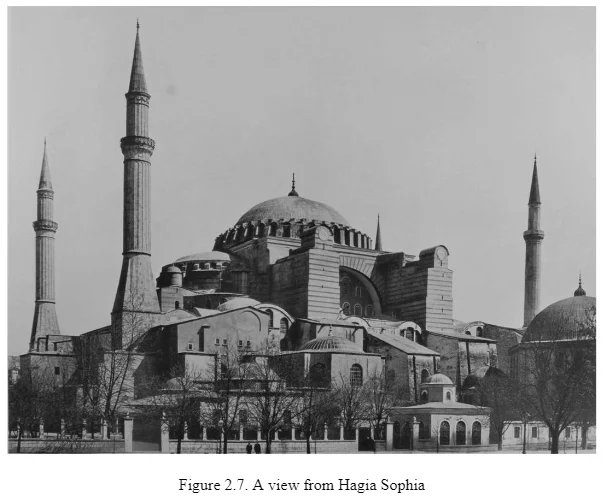

HOW HAGHIA SOPHIA WAS BUILT
Justinian selected two men named Anthemius and Isidore the Elder to manufacture his church building (Dovvney, 1950), "Contemporary journalists don't allude to Anthemius and Isidore as designers, however, in the 6th century, yet as mechanikoi or mechanopoioi," has observed the Indiana University W. Eugene Kleinbauer in a segment of the book "Hagia Sophia" (Scala Publishers, 2004). "These terms signify few specialists of human expressions of the plan, regardless of whether of structures or of machines or different works ..."
They constructed the Hagia Sophia in an extraordinary haste, completing it in less than six years. To place this in correlation, it took about a century for medieval developers to build the Notre Dame house of God in Paris.
This short development period seems to have prompted issues. Old sources, for example, the author Procopius, compose that the manufacturers had issues with the arch rooftop and this led to the structure nearly crumbling amid development. The arch utilized an arrangement of docks to channel its weight. "The docks over which the structure was being fabricated, unfit to hold up under the mass that was pushing down on them, some way or another or other all of a sudden began to split away and appeared to be on the purpose of collapsing..." composes Procopius. In the end, Anthemius and Isidore got the domed rooftop to stand and it was a radiant sight without a doubt. "It appears not to be established on strong brickwork, rather to be suspended from paradise by that brilliant chain, thus covering the space," composed Procopius (Agathias, 1975).
Lamentably, this rooftop did not stand. It crumbled around two decades later and it was a man named Isidore the Younger who was given the responsibility to manufacture another domed rooftop. It has kept going, with a few fixes, about 1,400 years, down to the present day (Devving et. al., 1940).
"The arch lays not on a drum but rather on pedantries, circular triangles that emerge from four gigantic docks that convey the heaviness of the dome. The pedantries made it conceivable to put the vault over a square compartment," composes specialist Victoria Hammond, who portrays the structure of the enduring Hagia Sophia arch, in a part of the book "Dreams of Heaven: The Dome in European Architecture" (Springer, 2005).
The embellishments inside the Hagia Sophia at the season of development were likely extremely straightforward; pictures of crosses for occasions were present. After some time, this changed to incorporate an assortment of resplendent mosaics.
Another part in the Hagia Sophia's life started in 1453AD. In that year the Byzantine Empire finished, with Constantinople tumbling to the armed forces of Mehmed II, sultan of the Ottoman Empire.
The style of the Hagia Sophia, specifically, its vault, would proceed to impact Ottoman designs, most prominently in the improvement of the Blue Mosque which was constructed in Istanbul amid the Seventeenth Century.
In 1934, the administration of Turkey secularized the Hagia Sophia and transformed it into an exhibition hall. The Turkish Council of Ministers expressed that due "to its authentic centrality, the transformation of the (Hagia Sophia) mosque, a remarkable design landmark of workmanship situated in Istanbul, into a historical centre will satisfy the whole Eastern world and its change to a gallery will make humankind gain another establishment of learning." [From Robert Nelson, "Hagia Sophia: 1850-1950: Holy Wisdom Modern Monument," University of Chicago Press, 2004).
Researching, fixing and rebuilding work proceeds right up till today and the Hagia Sophia is currently a vital site for the travel industry in Istanbul. It is a place that has been a piece of the social texture of the city during both the old and current eras.
STRUCTURE OF HAGHIA SOPHIA
DOME OF HAGHIA SOPHIA
The most important innovation in the architecture of Hagia Sophia, the size of a church for its unusual size, the size and height of the dome dominated in the middle space. The height of the dome covering the main room is 55.60 m from the ground and its diameter is 31.87 in the north-south direction and 30.86 m in the east-west direction. When the Hagia Sophia was under construction, marble, stone and brick were used by the architects in the construction of the building and light and solid bricks specially produced from the Rhodos soil were used to prevent the dome from collapsing easily in earthquakes.

When the first flat dome was constructed, earthquakes occurred during the August 553 AD and later on December 557 AD and this led to the cracking of the eastern half of the dome and the eastern part of the main dome collapsed during May 7th, 558 ADThe restoration of the dome was made by the young architect Isidoros, the nephew of Isidoros. Isidoros increased the height of the dome to 7 meters by adding a low pulley supporting the dome from the outside and supporting it with forty ribs and lightened by forty windows.
MOSAICS OF HAGHIA SOPHIA
LEON MOSAICS
The Pankration on the Emperor's Gate is in the middle of the mosaic depicting Jesus; Jesus sits on a throne with the back and is blessed with his right hand, holding an open Bible with pages in his left hand. The Greek word "Peace be with you. I am the world's divine light" is written on the Bible. On the right side is the Archangel Gabriel (Gabriel) on the medallion and on the left side the Virgin Mary is depicted in the medallion. At the foot of Jesus' feet, Eastern Roman Emperor VI Leon (816-912) is located in a prostrating manner. The mosaic is dated to the 10th century.
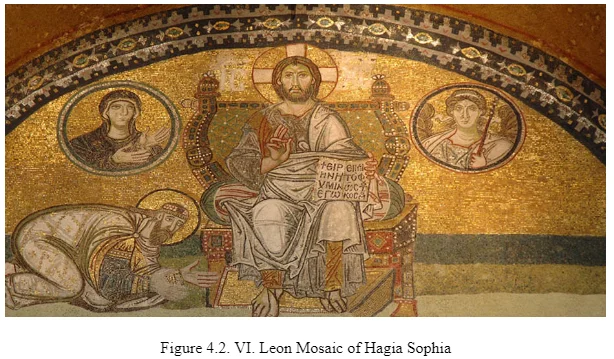
PRESENTATION MOSAICS
On the south side of the inner narthex, there is a mosaic of presentation which is one of the most important figure mosaics of the Hagia Sophia on the Vestibule Gate. This mosaic was unearthed by Fossati in 1849AD when the repairs in Hagia Sophia were almost over. This mosaic panel, which has a symmetrical layout, is composed of gold-leaf mosaics and on the throne without a backrest, there are abbreviated monograms of the words that state that Mary and the medallions on both sides of her head are METER and THEOU, that is, "Mother of God". Hz. Meryem in the lap of the child Hz. Jesus is depicted.

Emperor I. Konstantinos, who is the founder of the city on the left side of Mary, holds a model representing the city of Istanbul. In Greek, from the top to the bottom, with the Emperor I. Konstantinos; is the inscription of the "Great Emperor Konstantinos" among the saints. To the right of the Virgin Mary are Emperor Justinianos, the Virgin Mary and Hz. He is holding the model of Hagia Sophia which he has introduced to Jesus. Greek in uppercase with dark blue letters from top to bottom; He is writing the memoirs Famous Emperor Justinianos. In this mosaic, Emperor I. Konstantinos and Emperor Justinian were asked to emphasize that they were the protector of the city and the church. The mosaic panel is dated to the 10th century.
APSIS MOSAICS
In the middle of the quarter dome of the apse, the Mother of God, Mary (Theotokos), sitting on a throne decorated with precious stones and on a cushioned throne, has been depicted. He is holding Jesus. This mosaic is important in terms of forming the first figurative example after the period of Iconoclasm in the Hagia Sophia. The mosaic is dated to the 9th century.

DOME ANGEL DEPICTIONS
On the pendants, there are four angel figures which are not exactly identical to each other. These angels are depictions of the Seraphim, consisting of a head and six wings, believed to protect the throne of God in heaven. The angels in the east are made of mosaics, while the two angels in the west have been damaged in the Eastern Roman period and renewed as a fresco.
The faces of the angel figures in the pendants were covered with a star-shaped metallic cover in the Ottoman period. In 2009, during the mosaic repairs in the dome, the face of the angel depicted in the northeast was opened and the face of the angel was exposed.
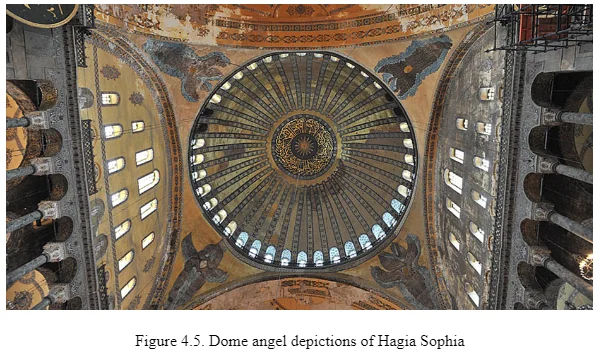
MOSAICS OF THE KOMNENOS
On the mosaic panel, the depictions contain Emperor II. Ioannes Komnenos and his wife Eirene with Hungarian descent and their son II Alexios is depicted as the child in the middle of the composition of the Prophet Hz. Jesus is depicted as standing with Mary. In the letters that surrounds the emperor's head, the phrase dün Porphyrogennetos Komnenos of the Romans salon is written, which is a sign of the nobility of the Emperor, who was born during the reign of his father. Around the head of the empress, "Psalm Augusta Eirene" is written. Empress Eirene was the daughter of the Hungarian King Laszlo, with braided red hair, coloured eyes, white skin and pink cheeks. On the other side of the panel, Prince II, who was the partner of his father in 1122 AD, died of illness at a young age is located in Alexios. In the mosaic, the Prince's facial features can be seen to have been collapsed and pale. This mosaic panel symbolizes the donation of the emperor's family to the Hagia Sophia. The mosaic panel is dated to the 12th century.
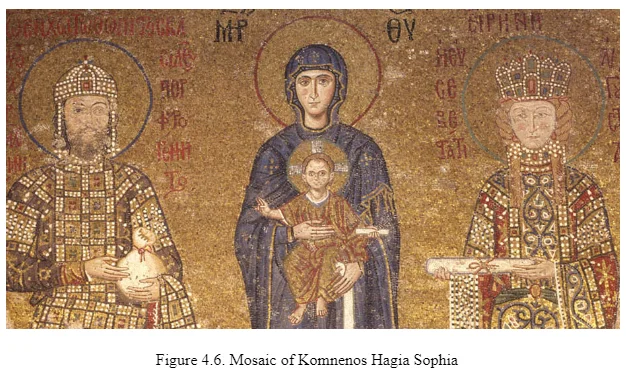
MOSAICS OF THE ZOE
In the mosaic panel, Emperor IX Konstantinos Monomakhos (1042AD- 1055AD) and the Empress Zoe have been depicted. The writing above the Emperor's head, is the "Faithful Ruler of the Romans, the God of God, Kulu Konstantinos Monomakhos". On the head of the Empress is the engraving of "Very Religious Agusta Zoe" and the ruler of the universe (Pantokrator) Hz. On both sides of the' head of Jesus, there are the IC and XC monograms containing the abbreviated letters of the name Jesus Khristos. This mosaic dates back to the 11th century.
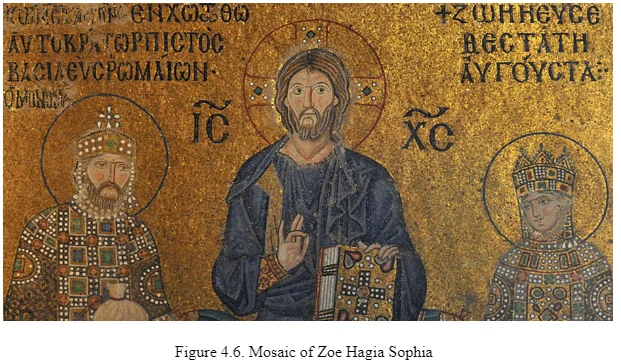
SULTAN ABDÜLMECID'S TUGRA MOSAIC
On the wall to the right of the main entrance door of the outer narthex, the monument of Sultan Abdülmecid is exhibited. Tugra was built by the Italian Master N. Lanzoni during the restoration of the Fossati Brothers in Hagia Sophia in the years 1847-1849. The Tugra gifted to Sultan Abdülmecid by Fossati; it has been processed with green coloured mosaics on the background of tesserae. The outer border of the mosaic Tugra is decorated with navy blue monochrome mosaic grains. In terms of design, the mosaic Tugra is very important in terms of reflecting the Ottoman Period and the Eastern Roman Period in terms of the material used.

ARCHITECTURE OF HAGHIA SOPHIA
Alfons Maria Schneider, who worked on behalf of the German Archaeological Institute in Hagia Sophia and at its vicinity, which was decided to be converted into a museum by the decision of the Council of Ministers in the 1930s, investigated the earliest period of the Hagia Sophia with his excavations, especially in the front courtyard and in the middle of it, aimed to find the monumental fountain. As a result of these studies, the entrance level and some architectural pieces of the building completed in 415AD were found in their original places only as filling material. This structure, known as a basilica-shaped and double-rimmed wooden roof, was similar to its predecessor.
To the northeast of Hagia Sophia is a light-yellow colour, domed and rounded. The building belonging to Theodosios is a treasure building. The treasury buildings in the churches contained not only materially valuable objects, but also religiously valuable items such as saints (Bury, 1923). The presence of a kiln known from the sources in the treasury building in Hagia Sophia is also important in terms of being the place where the bread given to the congregation was cooked. This place was used in the Ottoman period as a warehouse of the known soup kitchen, which was established in accordance with the Fatih Sultan Mehmet Foundation.

After the destruction of the 2nd Hagia Sophia, the 3rd Hagia Sophia was built at the same location on the rectification of the area of the architectural remains from the old building. Therefore, there is a shift towards west direction. According to some researchers, four support posts, which are thought to be made in order to reduce the effect of earthquakes on this part, are either X or XIV Century. Some researchers think that the Crusaders of the IV Crusade seized the city in 1204AD and then it was built in 1207AD by the Crusaders of the IV Crusade (Hill, 1996). There was also a bell tower on the second and third of these stables. In the nineteenth century, two long support walls were added to the north and south of the buttresses as a precaution against earthquakes which existed by Mimar Sinan.


There is an inscription on the wall in the southern part of the outer narthex of Hagia Sophia. A copy of the inscription, which was used upside down on the eaves of the tomb of Sultan Suleiman the Magnificent, was removed and hung from where he originally stood in Hagia Sophia. The inscription is about a church decision dated 1166AD. There is a mosaic Tugra on the south side of the central door in the transition from the outer narthex to the inner narthex. During the restoration work by the Swiss Fossati between 1847AD and 1849AD, Sultan Abdülmecid sought a portrait of the falling mosaics. This is important because it is the only monument of an Ottoman sultan with Byzantine mosaics in the world.
After passing the outer and inner narthex of Hagia Sophia, the big door in the middle of the main part is known as “the Emperor's Gate”. This door could be used by high ranking clergy and dynasty members of the Emperors’. On the right, Mary and on the left had the icon of Jesus, known as “the Mary shepherding Hodegetria” icon, at that time this icon was circulated in the city on Fridays. During an epidemic illness or an attack on the city, this icon again would be showed around the city to protect both the people and the city due to the belief in their miraculous powers. Furnishing floors were eroded due to people who touched these icons for centuries (Kahler and Mango, 1967).
In the Roman Empire, the dark purple coloured stone, a colour of special importance due to its difficult existence, began to be used in buildings of special importance with the discovery of the hearths in Central Egypt in 14 AD. This stone, also known as “porphyry”, was later used in the sarcophagi of the members of the imperial family. In order to save time and money, a number of different colours and materials are used in the Hagia Sophia (Krautheimer, 1986).
In order to reduce the load of the giant dome covering the main part of the structure, lightweight brick with volcanic soil mixture was used as the building material and the load distribution with half-domes was ensured. In order to fill the gaps in the passage of the dome to the main site, pedantries of unused sizes have been used. About 20 years after the completion of the construction, the dome collapsed as a result of an earthquake in 558AD. The highest point of the dome, which has a diameter of approximately 31 m, is approximately 56 m. There are forty windows on the dome. Four of them were coveredby a wall. The interior space is almost square and is 78 m x 72 m. IX, X, XIV, XVI and XIX. After the major earthquakes in the 20th century, the building was repaired. After its construction in 537AD, the dome was repaired and the present shape of the dome is 562 years old. Four of the forty windows were closed during repairs. The mosaics inside it indicate the different periods of the VI. and XIV. Century (Mainstone, 1988).
The faces of the six-winged Seraphim angels, who were found at four corners under the dome and believed to carry the throne of Jesus on the day of Judah, were revealed during the 2009 repairs. In fact, although four of them were made of mosaics, angels could not be repaired with mosaics in the Byzantine period, and angels were built with fresco. XIX. During the middle of the century, repairs were made on the faces of angels made of mosaic in the eastern direction. There are faces under the stars that cover the faces of other angels (Mango, 1962).
During the Fossati repairs in the middle of the 19th century, the face was closed. It is known that it is about 1.8 m in height and is made of mosaics. On the other hand, it is known that the faces of Seraphim depicted in the northwest and southwest are not depicted with mosaics but with frescos. The human and angelic mosaics were destroyed during the depiction of refraction during the period between 726AD and 1443AD and geometric ornaments and especially the depictions of the crosses were made (Mango, 1972). This application, which is mostly painted on the mosaics present in the ceilings, has been shown in the form of crosses made from mosaics from time to time.

XIX. During the 18th century repairs, some mosaics were removed from the upper floor of the building.
There is a coronation section in the south-eastern part of the main room. This practice became a necessity after the crowning of a Byzantine emperor by the patriarch in 457AD (Mark and Çakmak, 1992; Mango, 1978). After the construction of Hagia Sophia, the coronation ceremony started to be held here. This is the coronation point where the apostles of the Prophet Jesus (phub) are pointed out by moving from twelve rounds to the XI century to the south of the coronation space is located between the wall and the column (Mathews, 1971). The legs of the throne on the floor pass are still visible at the places. The Byzantine throne, which is in two parts, was found on one side while the emperor was sitting and on the other side there was a Bible pointing to Jesus (Moorhead, 1994).
Following the conquest of Istanbul in 1453AD, the building was converted into a mosque by the order of Mehmed.
The madrasah, which was built by Fatih Sultan Mehmed in the northwest of Hagia Sophia, initially started education in the place used by religious officials at the time of the church. XVI Fossati, who repaired Hagia Sophia in 1846-1849 because of being ruined at the end of century, was renovated in the Western style by the brothers (Necipoğlu, 1992).

Following the conquest, Fatih Sultan Mehmed built a wooden minaret next to the western half-dome of the weight tower. In style XV. century or the son of his son II. During the Bayezid period, the first minaret was made of bricks in the southwest. The minaret in the southeast belongs to the XVI century, northeast and northwest minarets belong to the XVII century These minarets on the upper parts of the XIX century repairs and decorations are visible. During these repairs, the level of the earliest brick minaret, which was lower than the others, was raised.
At the southeast part of Hagia Sophia, the construction of the tombs of the princes such as II. Selim, III. Murad III. Mehmed were undertaken, by XVI century and XVII century as this place was converted into a dynasty cemetery.
In the south-eastern part of the building there is a library built by Sultan Mahmud I in 1740. The works in this library, which were known to contain up to 4,000 manuscripts, were preserved here until 1968 and were later transferred to the Süleymaniye Library.
In the northeast of the building, there is the prince's ward, which was established to enable the sultans to worship at a separate place. The temple was rebuilt and expanded in the XVI century according to the fashion of the period during the repairs. There is also a separate entrance to the site and a resting section before the worship.
The Hagia Sophia, which has been extensively overhauled in the course of some repairs in the Turkish period, is the first church when it was built, the mosque after the conquest and the museum since the 1930s. Hagia Sofia, which has been standing for about 1,500 years and has the traces of the changes it has undergone, is one of the most important architectural works of Istanbul and the world today as it was in the past.
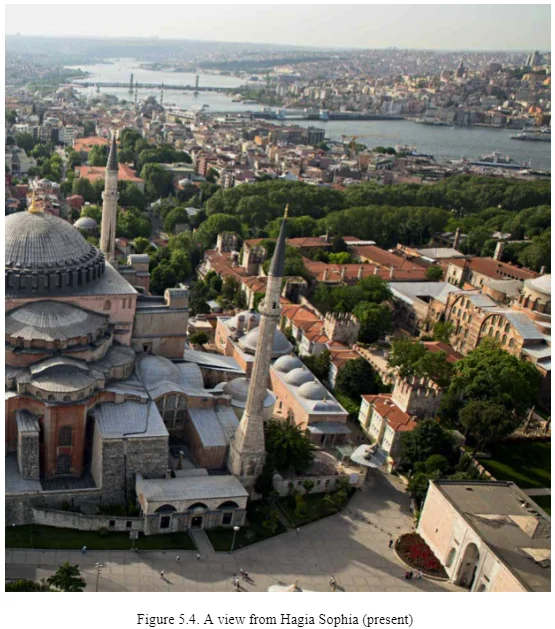
THEORETICAL BASE OF HAGHIA SOPHIA
There are different investigations which led to the planning of the structure of Hagia Sophia. Further, there are a few examinations concerning the impact of Byzantine architecture on the engineering of mosques. Also, less is on the effect of pedantries of Hagia Sophia on Mosque Architecture (Nelson, 2004).
Daylighting Analysis of Pendentive Domed Design of the Mosque amid Summer Solstice with Case Studies in Istanbul, Turkey.
This examination means to investigation and measures the lighting execution of one pendentive vault in the structure of the mosques. The contextual investigations are Firuzaga and Orhan Gazi Mosque in Istanbul. This investigation inspects whether the pendentive arch gives successful interior sunlight. It applies re-enactment examination. At last, it accepts the pendentive arch which gave out a phenomenal illuminance at all areas. Consequently, Muslim draftsmen fabricated the larger part of mosques with a pendentive arch rooftop (Hammond, 2005).
The vault does not rest on a drum and rather on pendentives: circular triangles that emerge from four huge docks which convey the heaviness of the dome. The pendentives made it conceivable to put the vault over a square compartment (Haddad). The vault of Hagia Sophia was a huge turn in the historical backdrop of building development. This significance originates from being a change from roundabout to square arrangement. Despite the fact that, this specific plan, a roundabout arch over a square base, is established in Persian catacombs and fire sanctuaries.
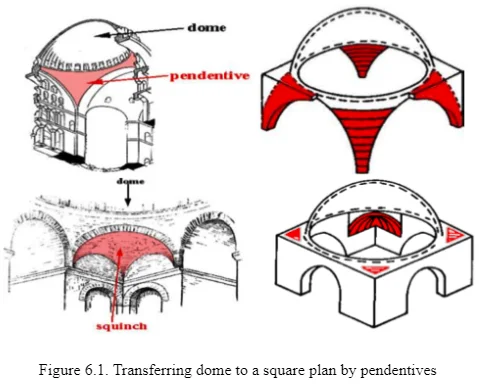
In spite of the fact that, the vault stands as the best engineering advancement and development which preceded Islam, the Muslim modellers created or presented various arches. In the Islamic time, Muslim planners created have huge and changed kinds of arches like smooth, ribbed and funnel-shaped with a neck (Grabar, 1963).
The principal arch known in Islam is the Dome of the Rock; it was worked by Abdul Malik container Marwan, trailed by the Dome of Eagle in the Umayyad Mosque worked by Walid receptacle Abdul Malik. Afterward, Muslims expanded utilizing vaults to have an arch for each mosque. Additionally, they utilized them over the places of worship and royal residences (Lehmann, 1945).
It is seen that Hagia Sophia was a wellspring of support for Ottoman modellers and designers, so was Byzantine engineering. Moreover, such impact surpassed Ottoman structures to all Muslim mosque design.
The little square-plan mosque finished with a round vault is a component of Ottoman design. Stool mosques performed step by step expansive focal vaults covering bigger internal square volumes. It was the impact of Hagia Sophia, after the victory of the Byzantine capital, which denoted a defining moment of Muslim engineering. In any case, the dominant part of huge mosque has a similar style to Hagia Sophia, similar to the mosque of Mehmed II, Mosque of Bayazid, Mosque of Süleyman, Mosque of Ali Paşa and the mosque of Selim II that he worked in Edirne (Saleh).
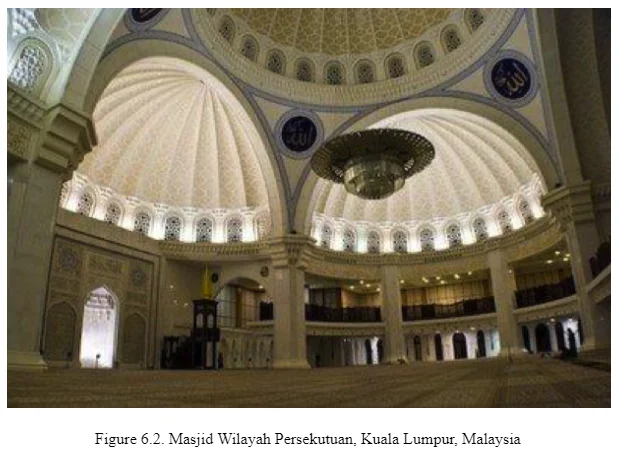
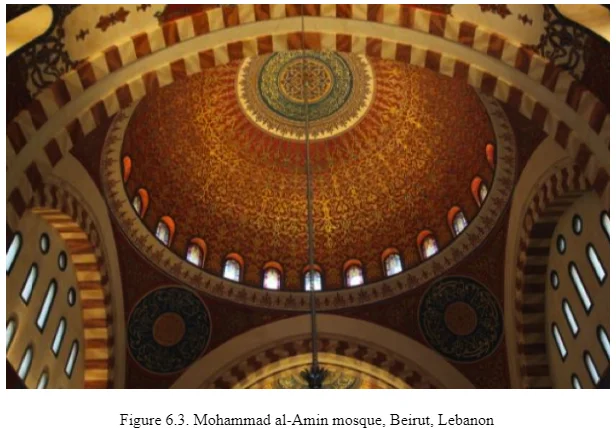
The engineering style of the Hagia Sophia kept on being imitated, adjusted and reinterpreted, as an immediate model for every single new mosque. All things considered, Muslim modellers, Sinan having been the leading figure among them and a few others, had later inundated in their work the engineering ideas of Hagia Sophia.
CONCLUSION
Hagia Sophia in Istanbul is a 6th century landmark of all-inclusive essentialness. Initially, a congregation, it was changed into an exhibition hall in 1935. It is perfect inside, beautified with vivid marbles and mosaics and these embellishments are noteworthy. Notwithstanding the attacks of time, the expanded number of guests and seismic tremor chances require cautious upkeep and maintenance of this fantastic structure. Turkish Ministry of Culture and Tourism is in charge of the preservation of the old landmark and the administration of the historical centre. In this article, protection endeavours expecting to safeguard the realness and the respectability of this World Heritage.
Hagia Sophia, from 4th century onwards, has been the most intriguing work with regards to Istanbul. Hagia Sophia Church, which we intend to give the observed engineering and verifiable capabilities, props up to give significance on religious and emblematic quality to the city. The building which once worked as a congregation at that point changed over to a mosque and has been lastly sorted out as a gallery on the hand endeavours to adapt to the static issues despite retaining the representative significance.
The Hagia Sophia in Istanbul has a place with its exceptional vault development amongst the remarkable and unprecedented building structures in the entire world. It mirrors the entirety of everything being equal and the learning of the established artifacts and it is one of the vital landmarks of the world legacy.
The vault mosaics have been cleaned and moderated with specialized help from UNESCO. Since 1993, a logical council goes about as a warning body to direct the preservation movement. Inside the structure characterized by the Committee, the rooftop covering was re-established, utilizing 3 mm thick lead sheets. The bond mortar on the inside and outside divider surfaces is being expelled. Amidst the on-going years, the reclamation of the west façade has been finished. Undertakings are in progress for the rebuilding of alternate façades. Inside the landmark, the bond mortar on the western portion of the north tympanum divider has been removed, uncovering fascinating development subtleties. The brickwork and the harms on the workmanship have been recorded and a proposition has been created for sewing the splits and re-plastering the surfaces with a lime-based mortar.
Because of past harms and the expanded number of guests, the splits on the marble floors of the ground and the exhibition floor are basic. Undertakings have been produced to monitor and re-establish the marble clearing by infusing between little splits, expelling unsatisfactory fixes and supplanting missing parts with new marble.
These days the building is under scrutiny supported by UNESCO.

REFERENCES
- Agathias, (1975) “The Histories V”, ed. J.D. Frendo.
- Ahunbay, Z., (2010) “Ayasofya’nın Dünya Mirası Değerlerinin Korunması ve Yönetimi”, Ayasofya Müzesi Yıllığı, 13, 57-78.
- Avşar, A., O., Özil, R., (2010) “Ayasofya Müzesinde UNESCO İşbirliği ile Yapılan Restorasyonlar Hakkında”, Ayasofya Müzesi Yıllığı, 13, 193-201.
- Bury, J., B., (1923) “History ofthe Later Roman Empire from the Death ofTheodosius I to the Death ofJustinian”.
- Devving, H., B., ve Dovvney, G., Procopius, (1940) “De aedificiis”, Loeb Classical Library, cilt 7.
- Diker, H., F., (2010) “2006-2010 Yılları arasında Ayasofya’da Yapılan Restorasyon Çalışmalarında Ortaya Çıkarılan Yeni Bulgular”, Ayasofya Müzesi Yıllığı, 13, 271-286.
- Dovvney, G., (1960) “Constantinople in the Age ofJustinian”.
- Duppel, C., (2010) “Ingenieurwissenschaftliche Untersuchungen an der Hauptkuppel Hauptpfeilern der Hagia Sophia in Istanbul”, KIT Scientific Publishing, Karlsruhe.
- Durukal, E., Cimilli, S., Erdik, M., (2000) “Dynamic Response of Hagia Sophia and Süleymaniye in Istanbul inferred from the recordings of 1999 Kocaeli and Düzce Earthquakes”, Compatible Materials. Recommendations for the Preservation of European Cultural Heritage PACT 59, Atina,19-28.
- Erdik, M., Croci, G., (2010) “Earthquake Performance of Hagia Sophia: A Review of Investigations”, Ayasofya Müzesi Yıllığı, 13, 101-134.
- Eyice, S., (1993) “Ayasofya, İstanbul Ansiklopedisi”, C I, 446-457.
- Freely, J., ve Çakmak, A., “İstanbul’un Bizans Anıtları”, Çev. Gülru Tanman İstanbul, 2005, s. 32.
- Fossati, G., (1980) “Die Hagia Sophia”, Die bibliophilen Taschenbücher.
- Gelibolulu M. A., “Künhü’l-Ahbâr”, Çev. M. Hüdai Şentürk, Ankara, 2003, c.2, s.63.
- Grabar, O., (1963) “The Islamic Dome; Some Considerations”, Journal of the Society of Architectural Historians, Vol. 22. No. 4, pp. 191-198.
- Haddad, M., H., “Encyclopedia of Islamic Architecture”, Eastern Publisher, Cairo, Egypt, Pp, 189,190.
- Hammond, V., (2005)"Visions of Heaven: The Dome in European Architecture", Springer.
- Hill, S., (1996) “The Early Byzantine Churches ofCilicia and Isauria”.
- Kâhler, H. ve Mango, C, (1967) “Hagia Sophia”.
- Krautheimer, R., (1986) “Early Christian and Byzantine Architecture”, 4.baskı.
- Lehmann, K., (1945) “The Dome of Heaven”, The Art Bulletin, Vol. 27. No. 1, pp. 1-27.
- Mainstone, R., L., (1988) “Hagia Sophia, Architecture, Structure and Liturgy of Justinian’s Great Church”, Thames and Hudson.
- Mango, C., (1962) “Materials forthe Study ofthe Mosaics of St, Sophia at İstanbul”, Dumbarton Oaks Studies 8, Washington, D.C.
- Mango, C., (1972) “The Art of the Byzantine Empire”, 3121453, Englevvood Cliffs.
- Mango, C, Byzantine Architecture (Nevv York, 1978).
- Mathevvs, T., F., (1971) “The Early Churches ofConstantinople: ArchitectureandLiturgy”, University Park.
- Moorhead, J., (1994) “Justinian”, London.
- Müller-Wiener, W., (1977) “Aya Sofya (Camii)”, Bildlexikon zur Topographie Istanbuls, Verlag E Wasmuth Tübingen, 84-96.
- Müler-Wiener, W., “İstanbul’un Tarihsel Topograyası”, Çev. Ülker Sayın, İstanbul, 2001, s.84.
- Necipoglu, Gülru, (1992) “The Life of an Imperial Monument: Hagia Sophia after ByzantiunY”, Mark ve Çakmak (editörler), Hagia Sophia from theAge ofJustinian to the Present, s. 195225.
- Nelson, R., (2004) "Hagia Sophia: 1850-1950: Holy Wisdom Modern Monument", University of Chicago Press.
- Saleh, M., L., “Domes in Islamic Architecture”, Arabian Renaissance, Bierut, Lebanon, P. 11.Schneider, A.M., (1941) “Die Grabung im Westhof der Sophienkirchezu”, İstanbul.
- Schlüter, S., (1999) “Gaspare Fossatis Restaurierung der Hagia Sophia 1847-49”, Die Hagia Sophia in Istanbul.Bilder aus Sechs Jahrhunderten und Gaspare Fossatis Restaurierung der Jahre 184749, Bern,139-148.
- Strube, C., (1973) “Die westliche Eingangsseite derKirchen von Konstantinopel in justinianischer Zeit”.
- Svvift, E., H., (1940) “Hagia Sophia”, New York.
- Şemseddin, K., “Haza Tarih-i Beyan-ı Bina-i Ayasofya-ı Kebir”, İstanbul Üniversitesi Nadir Eserler Kütüphanesi, T2637, s.2b-4b.
- Van Nice, Robert L, (1965 ve 1986) “St Sophia in istanbul: An Architectural Survey”, 2 cilt, Washington D.C.
- 24/7 Customer Support
- 100% Customer Satisfaction
- No Privacy Violation
- Quick Services
- Subject Experts



